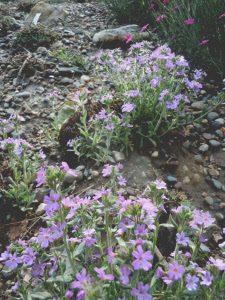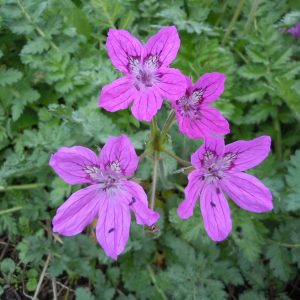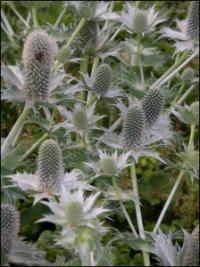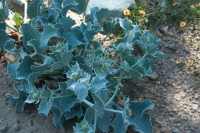Our Plants
Showing 209–216 of 587 results
-
Erinus alpinus Fairy foxglove, Alpine balsam Z 4-7
May- July violet, pink or white 5-petaled stars, self-sows
OUT OF STOCK
May- July violet, pink or white 5-petaled stars, self-sows
Size: 3” x 4” spreads
Care: sun to part shade in well drained soil
Native: Alps & Pyrenees
Awards: Royal Horticultural Society Award of Garden Merit.Erinus comes from Greek er meaning spring, for the time when this plant blooms. Collected by 1716. Wm. Robinson, father of mixed perennial border, called this a “pretty alpine plant.”
-
Erodium manescavii syn. Erodium manescani Heron’s bill Z. 5-8
Magenta saucer-shaped petals April-November. Seed’s tail like a corkscrew, flings seed as it dries.
Magenta saucer-shaped petals April-November. Seed’s tail like a corkscrew, flings seed as it dries.
Size: 12-18” x 8”
Care: Full sun in well-drained soil
Native: PyreneesErodium is Greek meaning “heron,” because the seed capsule resembles a heron’s head and bill. Collected before 1889. According to William Robinson, father of the mixed perennial border, this is “most showy (and) throws up strong flower stalks…each with 7 to 15 purplish flowers.”
-
Eryngium giganteum Miss Wilmott’s ghost SELF-SEEDING BIENNIAL Z 5-8
In summer, oval thistles top prickly green, turning steely blue, silvery, bracts – very ornamental.
In summer, oval thistles top prickly green, turning steely blue, silvery, bracts – very ornamental.
Size: 36" x 24"
Care: Full sun in moist well-drained, fertile soil. Be sure to let it drop its seeds & do not weed seedlings out the following spring.
Native: Caucasus Mountains
Awards: England's Royal Horticultural Society Award of Merit.Eryngium is Greek for thistle. This species introduced to England in 1820. Miss Ellen Willmott (1858-1934), a wealthy, expert, eccentric English gardener reputedly dropped seeds as she passed her neighbors’ gardens. The plants came up afterwards, her “ghosts.” Recommended by Gertrude Jekyll in 1908.
-
Eryngium maritimum Sea holly Z 5-10
Round thistles turning steely blue in July-August atop silver colored, prickly bracts. Attractive ivy-shaped prickly foliage.
OUT OF STOCK
Round thistles turning steely blue in July-August atop silver colored, prickly bracts. Attractive ivy-shaped prickly foliage.
Size: 12" x 10" slowly spreads
Care: Full sun in well-drained soil.
Native: Seacoasts of Europe“Eryngium” is Greek for thistle. Anglo-Saxons prescribed Sea holly root to cure the king’s evil, serpent bites, broken bones, stiff necks and melancholy. Also considered an aphrodisiac and brought on “kissing comfits.” This was identified by Dioscorides in De Materica Medica for medicinal use around 70 A.D. Eryngium was described in Gerard’s Herball in 1597 for its uses:” old and aged people that are consumed and withered with age, and which want natural moisture (and also) amended the defects of nature in the younger,” William Robinson, father of the mixed perennial border, considered this plant “very pretty.”
-
Eryngium planum Flat sea holly Z 5-9
Round thistles top prickly steel blue, silver colored, bracts June-August. Stems turn steel blue too. Deadhead for repeat bloom. Reseeds readily. Great cut flowers: dry or fresh…
Round thistles top prickly steel blue, silver colored, bracts June-August. Stems turn steel blue too. Deadhead for repeat bloom. Reseeds readily. Great cut flowers: dry or fresh.
Size: 36” x 18”
Care: Sun well-drained soil, drought tolerant
Native: E. EuropeEryngium is Greek meaning “thistle.” Described in Gerard’s Herball in 1597 for its uses to remedy: “old and aged people that are consumed and withered with age, and which want natural moisture (and also) amended the defects of nature in the younger.”
-
Eryngium yuccifolium Rattlesnake master Z 3-8
Blooms July-October, prickly round white umbels. Leaves like thinner versions of a Yucca
Blooms July-October, prickly round white umbels. Leaves like thinner versions of a Yucca
Size: 48” x 18”
Care: Full sun, moist well-drained soil, Heat and drought tolerant
Native: Eastern United States, Wisconsin native
Wildlife Value: attracts many kinds of insects including bees, wasps, flies, butterflies, skippers, moths, and beetles for nectar and for pollen. Deer resistant.
Awards: Missouri Botanic Garden Plant of Merit.Eryngium is Greek meaning “thistle.” The name “Rattlesnake master” comes from the use by Chickasaw shamans of chewing the root, blowing it on the hands and then picking up rattlers without injury or “from its virtues of curing the bite of that venomous reptile.” Gardeners’ Dictionary, 1768. Valued by American Indians for medicinal uses: a diuretic, stimulant, and cure for venereal disease and impotence, purify blood; Chippewa for joint inflammation and strengthen young children and Cherokee as a toothache remedy; Sioux: Root cured bladder ailments, and rattlesnake bites and scorpion stings. A concentration of boiled root increased virility of Sioux men. The Forest Potawatomi used Rattlesnake master as a good luck charm – the top placed in a pocket made the gambler sure to win. 1st collected in Virginia by Rev. John Banister who moved to colonial Virginia in 1678. A gunman mistakenly shot and killed him while he collected plants.
-
Erythronium americanum Yellow trout lily, Dog’s tooth violet Z 3-9
Downfacing yellow lily-like recurved flowers in spring above mottled foliage. Tops of petals slightly tan. Grows from deep rootstock or corm, 3-5” deep. In time it spreads from offshoots of the corm, resulting in colonies of trout lilies. Ephemeral – dies back in summer.
OUT OF STOCK – Only available for purchase in spring.
Downfacing yellow lily-like recurved flowers in spring above mottled foliage. Tops of petals slightly tan. Grows from deep rootstock or corm, 3-5” deep. In time it spreads from offshoots of the corm, resulting in colonies of trout lilies. Ephemeral – dies back in summer.
Size: 3-6” x 4”
Care: part to full shade in moist soil
Native: Eastern No. America, Wisconsin nativeCherokee warmed crushed leaves & poured the juice over wounds. According to Cherokee Yellow trout lily also remedied fever, fainting & removed slivers. Used by Iroquois as birth control for young women and to make fish bite (by chewing the root & spitting into the river.) In garden cultivation since 1665. Named Dog’s tooth because the white, oblong, fleshy root is shaped like a dog’s tooth.
-
Erythyranthe lewisii syn. Mimulus lewisii Lewis’ Monkeyflower Z 5-9
Bright rose trumpets with hairy yellow throats, flowers all summer
Bright rose trumpets with hairy yellow throats, flowers summer
Size: 2-3’ x 12"
Care: sun to part shade in moist to moist well-drained soil
Native: Alaska to California and as far east as Colorado
Wildlife Value: Nectar for hummingbirds and bees
Awards: Royal Horticultural Society Award of MeritFirst collected by Meriwether Lewis on the Lewis & Clark Expedition “on the head springs of the Missouri, at the foot of Portage hill,” in August 1805.







